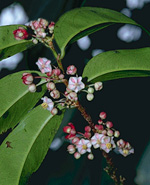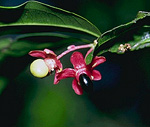 |
This family, which is widespread throughout the tropics of all continents,
is represented in Australia by only two genera, each with one species.
Brackenridgea is found in rainforests of north Queensland and the
Top End of the Northern Territory; the introduced Ochna is a minor
weed of bushland in New South Wales around Sydney.
Characteristic features of the family Ochnaceae in Australia include: - trees or shrubs with alternate, simple, leathery leaves
- flowers bisexual with 5-6 sepals, 5 or 10 petals and 5 or many stamens, all the parts free or almost so
- ovary comprising 2-15 free carpels each developing into a dark purple or black, somewhat fleshy drupelet borne on an often fleshy pad, in Ochna surrounded by the bright red, persistent sepals
Description
Evergreen or deciduous trees or shrubs. Internal secretions not obvious. Plants glabrous. Leaves alternate and spiral, petiolate; pulvinae present or absent. Stipules distinct and free from the petiole, lacerate or fimbriate, falling off early. Lamina simple, symmetric, lanceolate, ovate, elliptic, oblanceolate, obovate or oblong; base cuneate, attenuate or rarely cordate; margins entire or serrate, ±flat; venation pinnate, with the midrib conspicuous, and the tertiary venation reticulate or not; surfaces not punctate; herbaceous or leathery. All the flowers bisexual. Inflorescences terminal or axillary, consisting of racemes, panicles, cymes, thyrses or umbels. Bracts and bracteoles absent. Flowers stalked. Receptacle becoming swollen. Floral disc present or absent; nectaries absent. Perianth regular, of 2 dissimilar whorls, imbricate in bud. Calyx segments free, with 46 sepals, herbaceous. Corolla segments free, with (4–) 5 (–10) petals, alternating with the sepals, white, yellow or green, without contrasting markings, membranous; claws present or absent; lobes ±entire. Fertile stamens 4–5, opposite to the sepals, free of the corolla, free of the ovary and style, distinct from each other, grouped or fused into bundles or fused by their filaments into an open or closed tube, all ±equal. Staminodes present or absent. Anthers basifixed, not versatile, opening ?sideways by longitudinal slits, 2-celled. Ovary superior and sessile. Carpels 2–5, apparently free, or styles or stigmas fused. Style gynobasic or apparently terminal, single and unbranched, or single and branched above. Ovules 2 per carpel, sessile; placentation parietal or axile. Fruit fleshy, schizocarpic, of (1–) 5 single-seeded cocci borne on the enlarged receptacle (druparium); the perianth on the maturing fruit deciduous, dry and persistent, or growing larger. Disseminule micro-surface ±smooth, red, magenta, purple, violet or black, glossy. Seeds (1–) 5 per fruit. Aril absent. Cotyledons 2. Embryo straight or curved.
(Note: this description has been generated from the coded data compiled for the key. Any errors in the key data will be reflected in the descriptions.)
A treatment of the family Ochnaceae has not yet been published in the Flora of Australia. It will appear in Volume 6.
Australian genera of Ochnaceae (as recognised for the Flora of Australia)
* = all species introduced
Brackenridgea
*Ochna

|
  |

Brackenridgea australiana (flowers)
Photo: H.Nicholson © H. & N. Nicholson

Brackenridgea nitida (fruits)
Photo: H.Nicholson © H. & N. Nicholson

Ochna serrulata (fruits)
Photo: G.Leiper © G.Leiper
|
 |
|